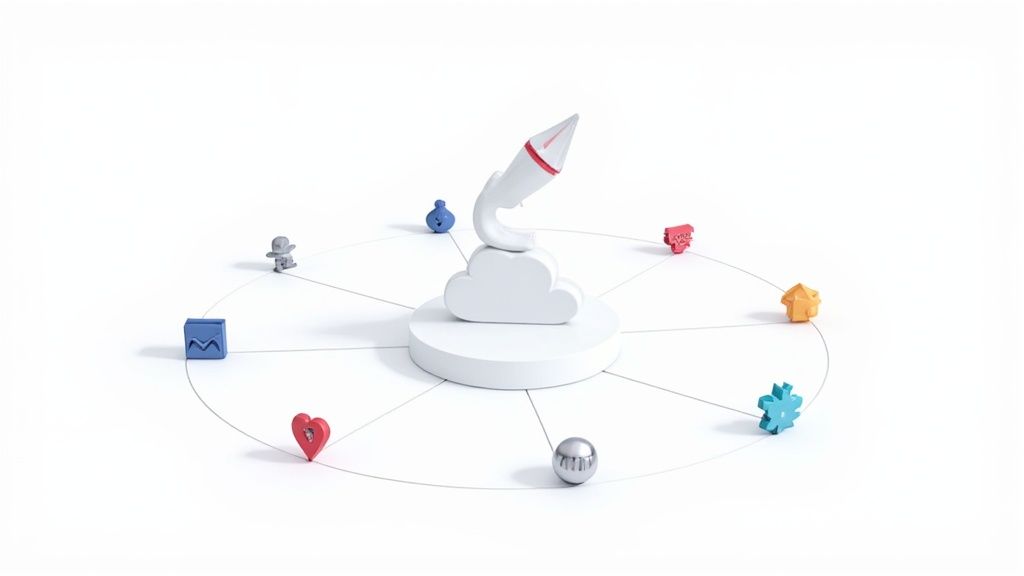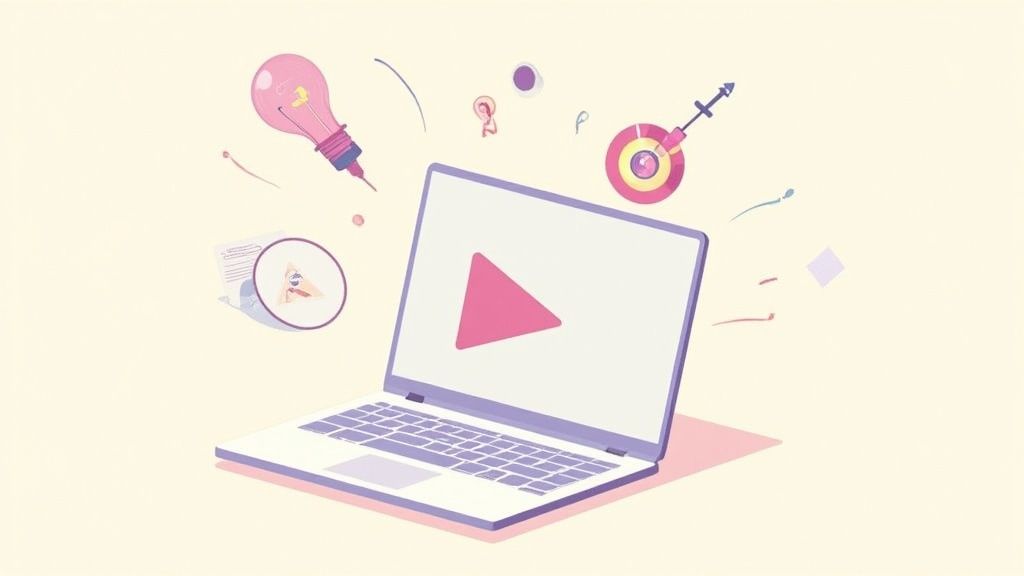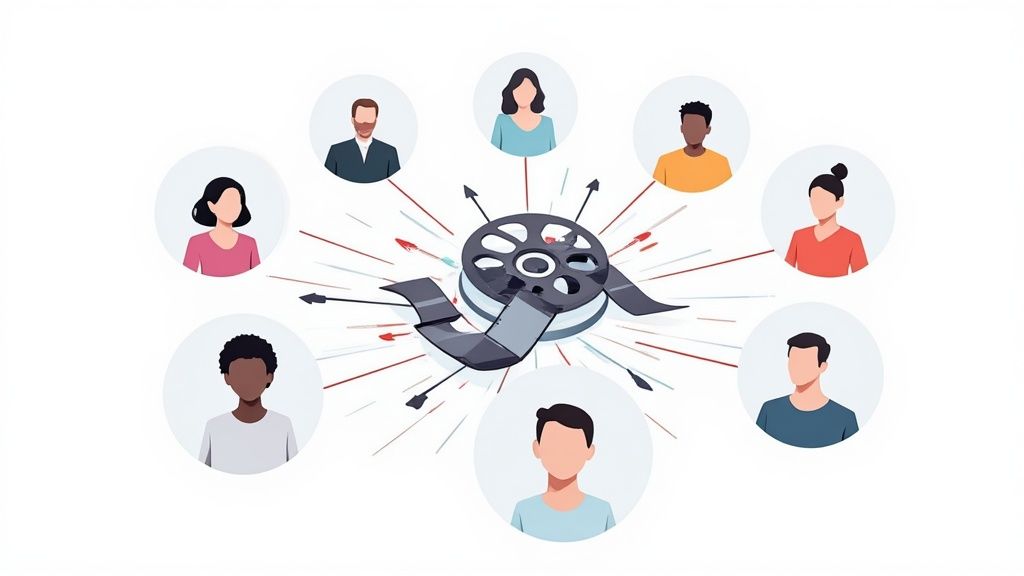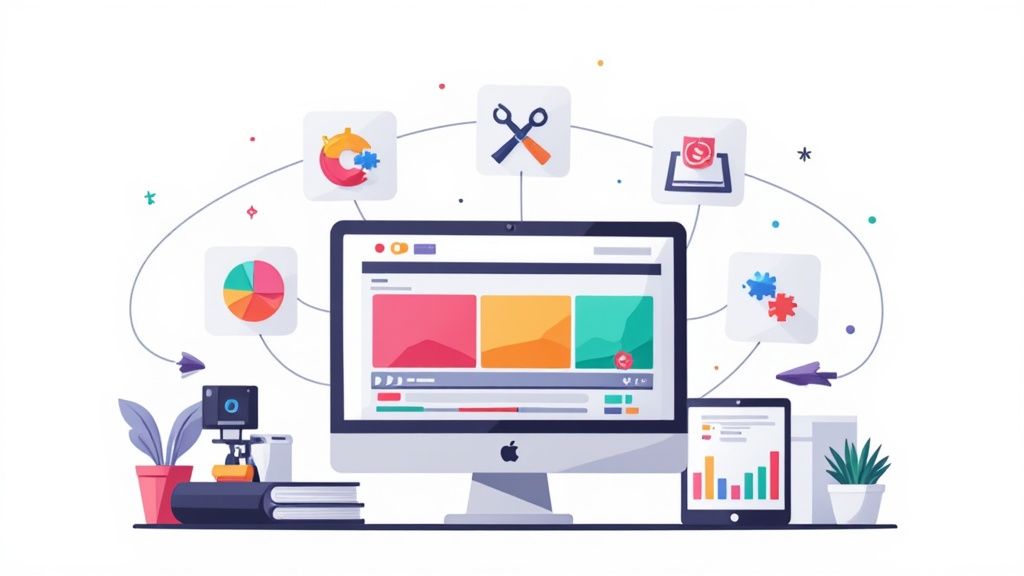12 Strategies For Driving SaaS Product Adoption



12 Marketing Strategies For Driving SaaS Product Adoption in 2025
Building a revolutionary SaaS product is only half the battle. The true challenge lies in transforming that innovation into an indispensable tool for your target audience, a process that moves a user from a curious first-time visitor to a loyal, enthusiastic advocate. This journey from initial sign-up to deep-seated adoption is powered by deliberate, strategic marketing. Without a clear plan to attract, engage, and retain users, even the most groundbreaking platform can fail to gain traction.
This guide moves beyond generic advice to provide a comprehensive deep dive into 12 marketing strategies for driving SaaS product adoption. We will explore the frameworks used by industry leaders and detail the practical steps you need to implement them effectively. You will learn how to leverage powerful models like Product-Led Growth (PLG), build a content marketing engine that attracts high-intent users, and design referral programs that turn your customer base into a growth channel.
Each strategy is designed to be actionable, providing a clear roadmap for accelerating user adoption, creating lasting engagement, and solidifying your product's place in a competitive market. From optimizing the onboarding experience to building a thriving user community, these proven tactics will equip you with the tools needed to not just launch your product, but to make it a market leader. This is your playbook for turning a great idea into a high-growth, widely adopted SaaS solution. We will cover everything from Freemium models and Partnership Marketing to Account-Based Marketing (ABM) and the power of social proof.
1. Freemium Model
The freemium model is a powerful marketing strategy for driving SaaS product adoption where you offer a core version of your product completely free, with no time limit. Users gain access to essential features, allowing them to experience the product's value firsthand without any financial commitment. This approach lowers the barrier to entry, attracts a wide user base, and builds a natural pipeline for converting free users into paying customers who need more advanced functionality.

This model excels by turning your product into its own best marketing tool. Instead of just reading about benefits, potential customers actively use and integrate the software into their workflows. Companies like Slack and Canva have mastered this, providing substantial value in their free tiers while creating compelling reasons to upgrade as user needs grow more sophisticated.
How to Implement a Freemium Model Effectively
Successfully implementing a freemium strategy requires a delicate balance. The free version must be valuable enough to retain users, but limited enough to create a clear incentive for upgrading.
- Define a Value Metric: Identify a key usage metric that correlates with customer growth, such as the number of users, projects, or storage space. This becomes the primary lever for your upgrade path. For example, Dropbox famously limits free storage space, encouraging upgrades as users become more dependent on the service.
- Create Clear Differentiation: Ensure the distinction between free and paid features is easy to understand. The premium tier should solve a bigger, more complex problem or offer significant efficiency gains that are not available in the free version.
- Optimize the Upgrade Path: Make the upgrade process seamless. Use in-app notifications and targeted email campaigns to highlight premium features at the exact moment a user hits a limitation or shows interest in advanced functionality. Continuously track conversion rates to refine this flow.
2. Product-Led Growth (PLG)
Product-Led Growth (PLG) is a go-to-market strategy where the product itself serves as the primary driver of customer acquisition, expansion, and retention. Unlike traditional sales-led models, PLG allows users to discover a product's value through direct interaction and experience. This approach puts the user experience at the core of the growth engine, turning product usage into a powerful, self-sustaining marketing channel.

PLG excels by creating a natural and organic adoption cycle. Companies like Calendly and Loom have mastered this strategy, where the act of using the product inherently exposes it to new potential users. For example, when someone receives a Calendly link or a Loom video, they experience the product's value proposition firsthand, often leading them to become users themselves. This viral loop is a hallmark of successful PLG and a key reason it is one of the most effective marketing strategies for driving SaaS product adoption.
How to Implement a PLG Strategy Effectively
A successful PLG model depends on creating a product that is both intuitive and inherently shareable. The goal is to minimize friction from sign-up to the moment a user experiences their first "aha!" moment.
- Design for Quick Wins: Create an intuitive onboarding experience that guides new users to value as quickly as possible. This initial success is crucial for retention and encourages deeper exploration of the product's features.
- Build in Virality: Integrate sharing and collaboration features directly into the core user workflow. Notion’s team-based documentation and Figma’s real-time design collaboration are perfect examples of features that naturally drive team adoption.
- Leverage User Behavior: For effective PLG, it's paramount to build a product that users genuinely need and love. This starts with truly understanding the Voice of Customer, ensuring your development efforts align with real user problems and desires. For more tips, you can explore additional insights on how to increase product adoption.
3. Content Marketing & SEO
Content marketing and SEO are foundational strategies for driving SaaS product adoption by creating and distributing valuable, relevant content that attracts your target audience organically. This approach builds authority, educates potential users, and captures leads actively searching for solutions. By ranking for relevant keywords, you position your product as the go-to answer for your audience's most pressing problems.
This strategy transforms your marketing into a long-term asset that continuously generates traffic and leads. Instead of paying for every click, you build an owned media channel that attracts qualified prospects. Companies like HubSpot and Ahrefs have built empires on this model, providing exceptional educational content that naturally funnels readers toward using their software to implement what they've learned.
How to Implement Content Marketing & SEO Effectively
A successful content strategy goes beyond just publishing blog posts; it requires a systematic approach to creation, optimization, and distribution that aligns with your business goals.
- Map Content to the Customer Journey: Create content that addresses user needs at every stage, from awareness (blog posts, guides) to consideration (webinars, case studies) and decision (comparison pages, demo videos). This ensures you have a relevant asset to engage prospects no matter where they are in their buying process.
- Focus on High-Intent Keywords: Target long-tail keywords that signal a user is close to making a purchase decision or solving a specific problem your SaaS addresses. Phrases like "best software for [task]" or "how to solve [problem]" attract highly qualified traffic more likely to convert.
- Repurpose Content for Maximum Reach: Extend the life and reach of your core content by repurposing it into different formats. A comprehensive guide can become a webinar, an infographic, a series of social media posts, and a video tutorial. For more inspiration, you can learn more about content marketing ideas on moonb.io.
4. Free Trial Strategy
A free trial strategy is a classic marketing approach for driving SaaS product adoption where you grant potential customers full access to your premium product for a limited time. Unlike the freemium model, the trial has a clear expiration date, creating a sense of urgency for the user to evaluate the software thoroughly. This tactic effectively removes the financial barrier to entry, allowing prospects to experience the product's complete value proposition firsthand and make a confident, informed purchasing decision.
This method works by letting the product sell itself through a hands-on experience. It is particularly effective for complex or high-value products where the benefits are best understood through usage. Companies like Salesforce and Shopify have built empires on this model, offering 30-day and 14-day trials, respectively. This allows users to set up their entire workflow and see tangible results before committing, significantly boosting conversion rates.
How to Implement a Free Trial Strategy Effectively
A successful free trial requires more than just unlocking features; it demands a strategic approach to guide users from initial interest to a paid subscription. The goal is to ensure they reach their "aha moment" before the trial period ends.
- Optimize Trial Length: The duration of your trial should align with your product's "time-to-value." If users can see significant benefits in a few days, a 7-day trial may suffice. For more complex platforms like CRMs or project management tools, a 14 or 30-day trial is often necessary for users to integrate the software properly.
- Provide Guided Onboarding: Don't leave users to figure things out alone. Implement a structured onboarding process with checklists, tutorials, and in-app guidance to direct them toward key features that demonstrate value quickly. This ensures they discover the functionality that will solve their biggest pain points.
- Create Urgency and Incentive: As the trial nears its end, use automated emails and in-app notifications to highlight the value they've received and what they'll lose. Offering a small, time-sensitive discount for converting before the trial expires can be a powerful final nudge to encourage adoption.
5. Referral Programs
Referral programs are a powerful marketing strategy that transforms your most satisfied customers into a dedicated growth channel. This approach systematically incentivizes existing users to recommend your SaaS product to their network, leveraging the immense power of word-of-mouth and personal trust. By offering rewards for successful referrals, you create a scalable, cost-effective engine for acquiring high-quality new users who are already warmed up to your product's value.

This strategy works because recommendations from trusted peers are far more persuasive than traditional advertising. Companies like Dropbox famously used this to achieve explosive growth, rewarding both the referrer and the new user with extra storage space. Similarly, Airbnb and Uber built their initial user bases by offering travel and ride credits, creating a viral loop that fueled rapid market penetration.
How to Implement a Referral Program Effectively
A successful referral program is not just about the reward; it is about making the entire sharing process effortless and motivating for your advocates.
- Make Sharing Frictionless: Design the referral process to be as simple as possible. Integrate one-click sharing links, pre-populated email templates, and easy access to social media sharing options directly within your application. The fewer steps a user has to take, the more likely they are to participate.
- Offer Valuable, Aligned Rewards: The incentive should be meaningful to your user base. While cash is an option, product-related rewards like feature upgrades, account credits, or increased usage limits (like Dropbox's storage) can be more effective at reinforcing product value and retaining both the referrer and the new customer.
- Time Your Requests Strategically: Prompt users to refer others after they have experienced a moment of success or satisfaction with your product. This could be after they complete a key task, achieve a milestone, or leave a positive review. A well-timed ask significantly increases the likelihood of a positive response.
6. Partnership & Integration Marketing
Partnership and integration marketing is a strategy that leverages collaborations with complementary SaaS platforms to create joint value and expand market reach. Instead of marketing in isolation, this approach taps into existing customer bases and ecosystems, allowing you to get in front of qualified audiences through trusted channels. It turns your product from a standalone tool into a connected part of a user's established tech stack.
This strategy is about mutual growth. By integrating with other tools, you enhance your product's functionality and stickiness while driving adoption for both you and your partner. Companies like Zapier and Salesforce have built empires on this concept. Zapier connects thousands of apps, driving adoption for every partner in its network, while the Salesforce AppExchange makes its core platform indispensable by allowing users to extend its capabilities.
How to Implement Partnership & Integration Marketing Effectively
A successful partnership strategy goes beyond simply listing another company's logo on your website. It requires a deep, mutually beneficial relationship built around a shared customer need.
- Identify Complementary Partners: Look for non-competing products that your ideal customers already use. The goal is to find tools where an integration would create a "1+1=3" effect, solving a bigger problem for the end-user.
- Build Valuable Integrations: Focus on creating deep, meaningful integrations that solve real workflow challenges. A superficial connection that only syncs a name and email is far less valuable than one that automates a complex, multi-step process for the user.
- Develop Co-Marketing Campaigns: Create joint marketing materials like webinars, blog posts, and case studies that highlight the combined value proposition. Promote these assets to both of your audiences to maximize reach. For broader reach and enhanced product adoption, learn more about building strategic partnerships to establish a strong foundation for these campaigns.
7. Social Proof & Customer Success Stories
Social proof is a psychological principle where people assume the actions of others reflect correct behavior for a given situation. In SaaS marketing, this translates to using customer testimonials, case studies, and reviews to build trust and demonstrate your product's real-world value. This strategy reduces perceived risk for potential buyers by showcasing proven results from users they can relate to, making it one of the most effective marketing strategies for driving SaaS product adoption.
This strategy turns happy customers into your most authentic and persuasive sales force. Instead of just taking your word for it, prospects see tangible evidence of success. Companies like Salesforce with its Trailblazer Community and HubSpot with its extensive library of industry-specific case studies have mastered this. They highlight measurable outcomes and relatable challenges, making the value proposition clear and compelling for new prospects.
How to Implement Social Proof Effectively
A powerful social proof strategy goes beyond simply collecting positive quotes. It involves strategically showcasing customer stories in a way that resonates with your target audience and directly addresses their pain points.
- Focus on Quantifiable Outcomes: Prioritize stories that include specific, measurable results. Instead of a vague testimonial like "it helped us grow," use one that says "we increased our lead conversion rate by 35% in six months." Metrics add credibility and help prospects build a business case.
- Feature Your Ideal Customer Profile: Select testimonials and case studies from customers who represent your ideal prospect. When potential buyers see companies similar to their own in size, industry, or use case succeeding with your product, the message becomes far more relevant and powerful. These narratives form a key part of your overall brand identity; you can see more compelling examples by exploring these brand story examples.
- Diversify Your Content Formats: Don't limit yourself to written case studies. Repurpose a single customer success story into multiple formats, such as video testimonials, quote graphics for social media, webinar presentations, and podcast interviews. This maximizes reach and appeals to different content consumption preferences.
8. Onboarding Optimization
Onboarding optimization is the systematic improvement of the new user experience to guide users to their first "aha!" moment as quickly as possible. This marketing strategy focuses on maximizing activation, engagement, and long-term retention by helping users understand and experience your product's core value immediately. A smooth onboarding process turns curious sign-ups into active, engaged users who are more likely to adopt the product into their regular workflow.

This strategy is about making a powerful first impression that establishes a foundation for future use. Companies like Duolingo excel at this with a gamified onboarding that gets users learning a new word in seconds. Similarly, Canva uses a template-based approach that allows new users to create a beautiful design within minutes, providing an instant sense of accomplishment and demonstrating the tool's power.
How to Implement Onboarding Optimization Effectively
Effective onboarding isn't a one-size-fits-all checklist; it’s a personalized journey designed to deliver immediate value. The goal is to reduce friction and build momentum from the very first interaction.
- Map to Activation Metrics: Define what a successful "activation" looks like for your product. Is it creating a project, inviting a team member, or integrating another tool? Build your onboarding flow to guide users directly toward completing that key action.
- Minimize Steps, Maximize Value: Every field, click, or pop-up in your onboarding process is a potential point of friction. Ruthlessly eliminate any step that doesn't directly contribute to demonstrating your product's value. Use progressive disclosure to introduce features gradually instead of overwhelming users upfront.
- Continuously A/B Test: Treat your onboarding flow like a core marketing funnel. Continuously test different copy, tutorials, layouts, and user paths to see what drives the highest completion and activation rates. Small tweaks can lead to significant improvements in long-term retention. To dive deeper into refining this critical stage, you can find more tips to enhance your customer onboarding process.
9. Community Building
Community building is a marketing strategy focused on creating and nurturing an engaged ecosystem of users around your SaaS product. This approach fosters peer-to-peer learning, support, and advocacy, transforming customers into a powerful extension of your brand. By building a space for users to connect, you cultivate long-term loyalty and generate invaluable feedback, user-generated content, and organic growth through member referrals.
This strategy turns passive users into active participants who feel invested in your product’s success. Companies like Salesforce with its Trailblazer Community and Figma have demonstrated how a thriving community can become a competitive advantage. They provide a platform for users to share templates, ask questions, and network, which deepens product engagement and reduces support costs.
How to Implement Community Building Effectively
A successful community offers tangible value beyond simple product support; it becomes a destination for professional growth and connection. Building one requires a thoughtful, user-centric approach.
- Seed the Community with Power Users: Identify your most engaged and knowledgeable customers and invite them to be founding members. These "power users" can help set a positive tone, answer early questions, and create the initial wave of valuable content that attracts new members.
- Provide Value Beyond Product Support: Offer exclusive content, educational resources, networking opportunities, or early access to new features. The HubSpot Community excels at this by providing forums, user groups, and certification programs that help members advance their marketing careers.
- Encourage and Structure Participation: Create programs like "member of the month," gamification with badges, or user-led events to encourage ongoing engagement. Actively participate to guide conversations and show that you are listening, but avoid over-moderating to allow for authentic peer-to-peer interactions.
10. Influencer & Thought Leadership Marketing
Influencer and thought leadership marketing is a strategy focused on leveraging trusted voices to build credibility and reach your target audience. Instead of promoting your product directly, you collaborate with industry experts, satisfied customers, and internal leaders who already have the attention and trust of your ideal customers. This approach builds brand authority by association and cuts through the noise of traditional advertising.
This strategy excels at building authentic connections with niche communities. Companies like Twilio have built powerful developer evangelist programs where experts create valuable technical content, while MongoDB partners with developer influencers for its community events. These efforts position the brand as a valuable resource, not just a vendor, making it a key part of the SaaS product adoption journey.
How to Implement Influencer & Thought Leadership Marketing Effectively
A successful campaign relies on authenticity and mutual value, not just transactional endorsements. The goal is to build genuine relationships that benefit your brand, the influencer, and their audience.
- Identify Aligned Voices: Look beyond follower counts. Prioritize influencers and experts whose audience demographics and values perfectly match your ideal customer profile. Use tools to analyze audience quality and engagement, ensuring their followers are your potential users.
- Provide Genuine Value: The best partnerships are not just about payment. Offer influencers early access to new features, co-creation opportunities for content, or direct access to your product team. This makes them feel like true partners invested in your success.
- Focus on Long-Term Relationships: Instead of one-off sponsored posts, build ongoing ambassador programs. Long-term collaborations create more authentic advocacy and allow influencers to integrate your product into their content naturally over time, yielding much higher returns.
11. Account-Based Marketing (ABM)
Account-Based Marketing (ABM) is a highly focused strategy that treats individual high-value accounts as markets in their own right. Instead of casting a wide net, ABM concentrates marketing and sales resources on a defined set of target accounts, orchestrating personalized campaigns designed to resonate with their specific needs and challenges. This approach is particularly effective for enterprise SaaS products with long sales cycles and high contract values.
ABM excels by fostering deep alignment between sales and marketing teams to deliver a cohesive, high-touch experience for key prospects. Companies like ServiceNow and DocuSign leverage this strategy to great effect, creating account-specific digital transformation campaigns that address the unique operational hurdles of Fortune 500 companies, thereby accelerating product adoption within entire organizations.
How to Implement Account-Based Marketing (ABM) Effectively
A successful ABM strategy relies on deep research, precise coordination, and personalized engagement across the entire buying committee rather than focusing on a single lead.
- Identify and Research High-Value Accounts: Use firmographic, technographic, and intent data to build a target account list. Invest heavily in researching each account’s business goals, pain points, and organizational structure to identify key stakeholders and decision-makers.
- Create Personalized Content and Campaigns: Develop bespoke content, such as case studies, ROI reports, and solution briefs, that speaks directly to the challenges of each target account. Your messaging should demonstrate a clear understanding of their industry and specific operational context.
- Orchestrate Multi-Channel Engagement: Coordinate touchpoints across multiple channels like email, social media, targeted ads, and direct outreach. Ensure that every member of the buying committee receives consistent, relevant messaging that guides them through the consideration process together.
12. Webinar & Educational Marketing
Webinar and educational marketing is a strategy centered on providing genuine value to your target audience through free online training, workshops, and courses. Instead of directly selling your product, you teach concepts and solve problems that your ideal customers face, naturally showcasing how your SaaS tool facilitates those solutions. This approach positions your brand as a trusted authority, builds a relationship with prospects, and drives product adoption by demonstrating its utility in a real-world, educational context.
This strategy turns marketing into a service. It excels by addressing user pain points head-on, providing actionable knowledge that builds confidence and loyalty. Companies like HubSpot Academy and Canva Design School have built massive communities by offering comprehensive, free education that not only attracts users but also ensures they are proficient enough to get maximum value from the product, making them stickier customers.
How to Implement Webinar & Educational Marketing Effectively
Success with this strategy hinges on prioritizing education over sales. Your content must be genuinely helpful, with the product acting as a supportive element rather than the main focus. Creating a comprehensive customer education strategy is key to aligning your content with business goals.
- Focus on Customer Pain Points: Develop content around topics your ideal customers are actively searching for answers to. Use keyword research and customer feedback to identify their biggest challenges, and design webinars that offer practical, step-by-step solutions.
- Make it Interactive and Engaging: Go beyond a simple presentation. Incorporate live polls, Q&A sessions, downloadable worksheets, and interactive exercises to keep your audience engaged. This transforms passive viewing into an active learning experience and provides valuable direct feedback.
- Repurpose Content for Maximum Reach: Record every webinar and turn it into on-demand content. Edit the recording into smaller video clips for social media, create blog posts summarizing key takeaways, and bundle related sessions into a free course to continuously generate leads and educate your market long after the live event is over.
12 SaaS Marketing Strategies Comparison
Crafting Your Blueprint for Sustainable SaaS Growth
Navigating the landscape of SaaS growth requires more than just a great product; it demands a sophisticated, multi-channel marketing engine. The journey from initial user acquisition to deep, sustained product adoption is complex, but it's not a mystery. By understanding and implementing the right combination of the 12 marketing strategies for driving SaaS product adoption we've explored, you can build a powerful and predictable growth flywheel for your business.
The strategies we've detailed, from the acquisition-focused power of Freemium models and Product-Led Growth to the retention-boosting impact of optimized onboarding and community building, are not isolated tactics. They are interconnected components of a holistic adoption ecosystem. A seamless free trial experience feeds directly into effective onboarding, which in turn creates the happy users who become powerful advocates through referral programs and compelling customer success stories.
Synthesizing Your Strategy: From Theory to Action
The key takeaway is that there is no one-size-fits-all solution. Your ideal marketing mix will depend on your product's complexity, your target audience's sophistication, and your company's stage of growth. A B2B enterprise platform might lean heavily on Account-Based Marketing and educational webinars, while a B2C productivity tool could achieve massive scale through a PLG motion and viral referral loops.
To move forward effectively, avoid the temptation to tackle everything at once. This leads to diluted focus and mediocre results. Instead, adopt a phased, strategic approach:
- Audit & Align: Begin by evaluating your current strengths and weaknesses. Where are users dropping off? What channels are already showing promise? Identify the two or three strategies from this list that most directly address your biggest adoption hurdles or align with your core product value.
- Implement & Instrument: Launch your chosen initiatives with clear key performance indicators (KPIs). For a new content marketing push, this means tracking organic traffic and sign-ups from blog posts. For an onboarding optimization project, it means monitoring feature adoption rates and time-to-value for new users.
- Measure & Iterate: Adoption marketing is a continuous loop of learning and refinement. Use the data you collect to double down on what works and pivot away from what doesn’t. An underperforming referral program might need better incentives, while a successful webinar series could be expanded into a full-fledged educational course.
The Unseen Engine: Scaling Your Creative Execution
A critical, often underestimated, component of executing these strategies is the relentless need for high-quality creative assets. Every single one of these 12 tactics relies on creative content to function.
Consider the creative demands: SEO requires well-researched articles and landing pages. Webinars need polished slide decks and promotional videos. Social proof is brought to life through professionally produced case study videos and testimonials. Partnership marketing depends on co-branded ebooks and one-pagers.
As you scale your marketing efforts, the demand for this creative output grows exponentially. This is where many marketing teams hit a bottleneck, slowing down their momentum. Your team's strategic brilliance can only be realized through consistent, world-class execution.
Mastering these 12 marketing strategies for driving SaaS product adoption is the blueprint for building a category-leading company. It transforms growth from a game of chance into a science of strategic execution. By selecting the right tactics, measuring their impact, and underpinning your efforts with a scalable creative infrastructure, you're not just acquiring users. You're building a loyal, engaged, and ever-growing base of advocates who will power your SaaS to new heights.






